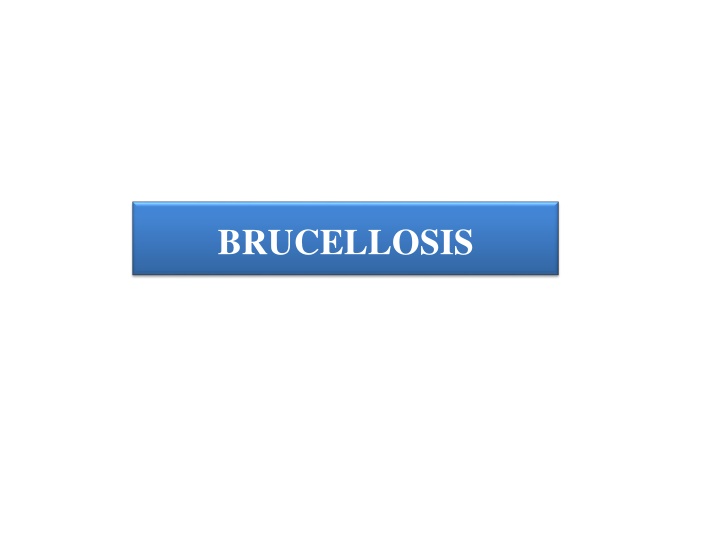
Brucellosis: Causes, Transmission, and Control Measures
Learn about brucellosis, a disease caused by Brucella abortus, its impact on cattle and humans, transmission methods, clinical pathology, and control strategies like vaccination and eradication. Understand the risk factors, epidemiology, and associated lesions to effectively manage and prevent the disease.
Download Presentation

Please find below an Image/Link to download the presentation.
The content on the website is provided AS IS for your information and personal use only. It may not be sold, licensed, or shared on other websites without obtaining consent from the author. If you encounter any issues during the download, it is possible that the publisher has removed the file from their server.
You are allowed to download the files provided on this website for personal or commercial use, subject to the condition that they are used lawfully. All files are the property of their respective owners.
The content on the website is provided AS IS for your information and personal use only. It may not be sold, licensed, or shared on other websites without obtaining consent from the author.
E N D
Presentation Transcript
BRUCELLOSIS ASSOCIATED WITH BRUCELLA ABORTUS (BANGS DISEASE) ETIOLOGY Brucella abortus a gram-negative, facultative intracellular coccobacillus of the family Brucellaceae, is the organism responsible for bovine brucellosis. B. abortus is one of 10 species with validly published names, including B. melitensis, B. abortus, B. suis, B. ovis, B. neotomae, B. canis, B. ceti, B. pinnipedialis, B. microti, and B. inopinata, each of whichhas specific host preferences. B. abortus is responsible for bovine brucellosis, B. melitensis is the main causative agent of brucellosisin small ruminants and men, B. suis forbrucellosis in swine, and B. ovis in sheep. In temperate climates, infectivity may persist for 100 days in winter and 30 days in summer. The organism is susceptible to heat, sunlight, and standard disinfectants, but freezing permits almost indefinite survival
EPIDEMIOLOGY Major cause of abortion in cattle in countries without a national control program. Undulant fever in humans; is an important zoonosis. Sexually mature animals susceptible; Outbreaks occur in first-calf heifers, older cows areinfected but do not abort. Transmitted directly from the infected animal to the susceptible animal by uterine discharges. Congenital infection occurs. Infection in wildlife species but significance to domestic animals unknown. Infection introduced into herd by unknown infected carrier animal. Natural infection and vaccination result in immunity to abortion but not infection, and infected animals remain serologically positive for a long time. RISK FACTORS 1. Animal risk factor: Susceptibility of cattle to B. aborts infection is influenced by the age, sex, and reproductive status of the individual animal. 2. Management risk factor. 3. Pathogens risk factor .
TRANSMISSION The disease is transmitted by ingestion, penetration of the intact skin and conjunctiva, and contamination of the udder during milking. Intraherd spread occurs by both vertical and horizontal transmission. Horizontal transmission is usually by direct contamination and, although the possibility of introductionof infection by flies, dogs, rats, ticks, infected boots, fodder, and other inanimate objects exists, it is not significant relative to control measures. Congenital Infection: Congenital infection may occur in calves born from infected dams but its frequency is low. Signs 1. Abortion epidemics in first-calf unvaccinated heifers after fifth month of pregnancy. Retention of the placenta and metritis are common sequelae to abortion. Mixed infections are usually the cause of the metritis, which may be acute, with septicemia and death following, or chronic, leading to sterility. 2. Orchitis and epididymitis in bulls. Synovitis (hygroma) occurs. Fistulous withers in horses.
Clinical pathology Serology. Serum agglutination test is standard test. Rose Bengal test (rapid screening test). Complement fixation test. ELISA test. Milk ring test. False-positive reactors are a major problem. LESIONS Necrotizing placentitis, inflammatory changes in fetus. Diagnostic confirmation Culture organism from fetus. Positive serologic test in unvaccinated animal. Treatment No treatment. Control Test and reduce reservoir of infection. Quarantine. Depopulation. Vaccination to reduce incidence of abortion and percentage of infected animals. Eradication on herd and area basis by test and cull.
Aetiology L. monocytogcncs is widespread in nature and has characteristics that allow its survival and growth in a wide variety of environments. There is a highly diverse range of strains some of which have the capability of causing disease in animals and humans. Epidemiology 1. The disease is important in North America, Europe, the UK, New Zealand, and Australia. 2. Seasonal occurrence, probably associated with seasonal feeding of Silage, with the highest prevalence in the months of December through May. 3. Listeriosis is primarily a disease of ruminants particularly sheep, and the major diseases associated with L. monocytogencs are encephalitis and abortion. In ruminants it also produces syndromes of septicaemia, spinal myelitis, uveitis, gastroenteritis, and mastitis. 4. Abortion may also occur sporadically, which is usually true in cattle, but in sheep and goats it more commonly occurs as an outbreak
Source of infection 1. Infected animals faeces, human faeces, farm slurry, sewerage sludge, soil, farm water troughs, surface water, plants, animal feeds and the walls, floors, drains, etc. of farms and other environments. Transmission 1. Ingestion of contaminated material with causative agent. Risk factors 1. Poor nutritional state 2. Sudden changes of weather to very cold and wet 3. The stress of late pregnancy and parturition 4. Transport 5. Long periods of flooding with resulting poor access to pasture.
PATHOGENESIS In most animals, ingestion of the organism, with penetration of the mucosa of the intestine, leads to an inapparent infection with prolonged faecal excretion of the organism and to a subclinical bacteraemia, which clears with the development of immunity. The bacteremic infection is frequently subclinical and may be accompanied by excretion of the organism in milk. Septicemic listeriosis, with or without meningitis, occurs most commonly in neonatal ruminants and in adult sheep and goats, particularly if they are pregnant and when the infection challenge is large. The organism is a facultative intracellular pathogen that can infect cells, including intestinal cells, by directed endocytosis. It can survive and grow in macrophages and monocytes In pregnant animals invasion of the placenta and fetus may occur within 24 hours of the onset of bacteraemia. Oedema and necrosis of the placenta leads to abortion, usually 5-10 days post infection. Infection late in pregnancy results in stillbirths or the delivery of young that rapidly develop a fatal septicaemia. Maternal metritis is constant and if the fetus is retained a fatal listerial septicemia may follow. Infection of the uterus causing abortion and intrauterine infection occurs in all mammals. Encephalitis in ruminants occurs as an acute inflammation of the brainstem and is usually unilateral. The portal of entry is by ascending infection of the trigeminal or other cranial nerves following loss of the integrity of the buccal mucosa resulting from trauma, the shedding of deciduous or permanent teeth or from periodontitis Spinal myelitis possibly results from ascending infection in the sensory nerves of the skin following dermatitis from prolonged wetting of the fleece. Mastitis L. monocytogenes is rarely found to be a cause of mastitis in cattle
CLINICAL FINDINGS When disease occurs it is usual to have an outbreak of either encephalitis or abortion. 1. Encephalitis is the most prevalent manifestation in sheep. A. In sheep, early signs are separation from the flock, and depression with a hunched stance. Sheep approached during this early stage show a frenetic desire to escape but are uncoordinated as they run and fall easily. Signs vary between individual sheep but incoordination, head deviation sometimes with head tilt, walking in circles, B. unilateral facial hypalgesia and facial paralysis are usually present. Facial hypalgesia can be detected with pressure from a hemostat and the facial paralysis is manifest with drooping of the ear, paralysis of the lips and ptosis on the same side of the face as the hypalgesia. C. There is ataxia, often with consistent falling to one side, and an affected sheep may lean against the examiner or a fence. The affected animal becomes recumbent and is unable to rise, although often still able to move its legs. Death is due to respiratory failure. D. 2. Listerial abortion A. Outbreaks of abortion are recorded in cattle but occur more commonly in sheep and in goats. Abortion due to this organism is rare in pigs. B. In sheep and goats abortions occur from the 12th week of pregnancy onwards, the after birth is usually retained, and there is a blood stained vaginal discharge for several days. There may be some deaths of ewes from septicemia if the fetus is retained.
Diagnosis a) Clinical finding and case history. b) Culture. Pleocytosis and elevated protein in cerebrospinal fluid with encephalitis. c) Lesions (Microabscesses in brainstem in listerial encephalitis, spinal cord in spinal myelitis, intestine in enteritis. Visceral lesions in septicemia). Differential diagnosis A. Encephalitis Pregnancy toxemia in sheep Nervous ketosis in cattle Rabies Gid Polioencephalomalacia Middle ear disease Scrapie B. Abortion with the diseases that causes abortion in sheep, goat and cattle.
TREATMENT The intravenous injection of chlortetracycline (10 mglkg BW per day for 5 d) is reasonably effective in meningoencephalitis of cattle but less so in sheep. Penicillin at a dosage of 44 000 IU/kg BW given intramuscularly daily for 7 days, and in many cases for 10-14 days, can also be used. Chlortetracycline or penicillin . Must b e given early in clinical disease Control Control of listerial growth in feeds. Vaccination
CONTAGIOUS BOVINE PLEUROPNEUMONIA (LUNG SICKNESS, CBPP)
AETIOLOGY Mycoplasma mycoides subsp. Mycoides EPIDEMIOLOGY CBPP is considered one of the economically most important cattle plagues affecting Africa, and with relaxation of import controls and increase in international trade, it presents a constant risk for disease-free countries. The World Organization for Animal Health (OIE) has categorized CBPP as so-called List A disease.
Methods of Transmission Source of infection is infected animals, also recovered animal become carrier for 3 years. Transmission occurs from direct andrepeated contacts between sick and healthyanimals. The principal route of infection isby the inhalation of infective droplets fromactive or carrier cases of the disease. Economic Importance CBPP is considered as one of the two economically most important diseases of cattle (beside rinderpest) in Africa. Direct losses are from mortality, reduced milk yield, vaccination costs, and disease surveillance. The indirect costs associated with the chronic nature of the disease are more difficult to assess and include decreased weight gain or loss of body weight, impaired working ability,reduced fertility, losses resulting from quarantine, and losses related to restrictions of trade and cattle movement.
PATHOGENESIS The organism invades the lungs of cattle and causes a mycoplasmemia; this results in localization in numerous other sites including the kidneys, joints and brain, resulting in high morbidity and mortality. An essential part of the pathogenesis of the disease is thrombosis in the pulmonary vessels, probablybefore the development of pneumonic lesions. The production of hydrogen peroxide and other active oxygen species is widely believed to play an important role in mycoplasma pathogenicity, and it has been demonstrated to result in lysis of erythrocytes, the peroxidation of lipids in M. mycoides infected fibroblasts, and inhibition of ciliary movement in tracheal organ cultures infected with M. mycoides and M. ovipneumoniae. Death results from anoxia and presumably from toxemia
CLINICAL FINDINGS There is considerable variation in the severity of clinical disease from hyper acute to acute to chronic and subacute forms. With acute presentation, high disease incidence of nearly 90% and fatality rates of 50% and higher are observed. Acute disease is the common presentation in outbreaks occurring in previously unaffected regions. Mild or even subacute forms with low mortality rates are common presentation in zones where the disease in endemic. Approximately 25% of the infected cattle have been estimated to remain as recovered carriers with or without clinical signs. Acute form: After an incubation period of 3 to 6 weeks (in occasional instances up to 6 months), there is a sudden onset of high fever (40 C [105 F]), a drop in milk yield, anorexia, and cessation of rumination. Coughing, at first only on exercise, and thoracic pain are evident; affected animals are disinclined to move, standing with the elbows out, the back arched, and the head extended. Respirations are shallow, rapid, and accompanied by expiratory grunting. Pain is evidenced on percussion of the chest. Auscultation reveals pleuritic friction sounds in the early stages of acute inflammation, and dullness, fluid sounds, and moist gurgling crackles in the later stages of effusion. Edematous swellings of the throat and dewlap may occur, and swelling of the large movable joints may be present. In calves, valvular endocarditis and myocarditis may occur. In fatal cases death occurs after a variable course of disease from several days to 3 weeks. In the peracute form, affected cattle may die within 1 week after the onset of respiratory distress. Chronic and Subacute Forms: Recovered animals may be clinically normalbut in some an inactive sequestrum forms in the lung
DIFFERENTIAL DIAGNOSIS Rinderpest Foot and mouth disease Hemorrhagic septicemia Theileriosis (East Coast fever) Ephemeral fever Pulmonary abscesses Tuberculosis Actinobacillosis Echinococcal (hydatid cysts)
CLINICAL PATHOLOGY Complement fixation test (CFT), Competitive enzyme-linked immunosorbent assay (C-ELISA). Nucleic acid recognition of causative organism with polymerase chain reaction (PCR). NECROPSY FINDINGS Lesions are confined to the thoracic cavity and lungs, and the lesions are usually unilateral. The pleural cavity may contain large quantities of clear, yellowish-brown fluid with pieces of fibrin. This fluid is ideal for culture of the organism. Caseous fibrinous deposits are present on the parietal and visceral surfaces of the pleura. The interlobular septae are prominently distended with amber-colored fluid surrounding distended lymphatics. This fluid distinctly outlines the lobules, which vary in color, with red, gray, or yellow hepatization
TREATMENT Not recommended because of usually poor treatment response and the risk of developing carrier animals.In contrast the treatment of in-contact animals appeared to considerably reduce disease transmission, which resulted in amarked decrease in the disease occurrence, morbidity, and mortality rates in affected herds. Tulathromycin (2.5 mg/kg SC as single dose) (R-3) Florfenicol (20 mg/kg q48 IM) (R-3) Tilmicosin (10 mg/kg SC as single dose) (R-3) Gamithromycin (6 mg/kg SC as single dose (R-3) Danofloxacin (2.5 mg/kg q24h SC) (R-3) Oxytetracycline (10 mg/kg IM q24 for at least 4 days (R-3) *The use of antimicrobials is legally prohibited in many countries affected by CBPP.
CONTROL Identification and slaughter of sick animals. Vaccination followed by test and slaughter. Antimicrobial therapy of exposed animals may reduce disease transmission but is prohibited in many countries. Establish disease-free areas. Control movement of cattle in control areas.An increasing body of evidence suggests that use of antimicrobials, primarily as a part of a disease control program, should be reconsidered Danofloxacin (2.5 mg/kg q24h SC over three consecutive days) (R-2)21 Tulathromycin (2.5 mg/kg SC as single dose) Tilmicosin (10 mg/kg SC as single dose) Gamithromycin (6 mg/kg SC as single dose) Florfenicol (20 mg/kg q48 IM) Oxytetracycline long-acting formulation (20 mg/kg IM) Vaccination Vaccination with T1/44 or T1SR MLV vaccines (R-1)






















